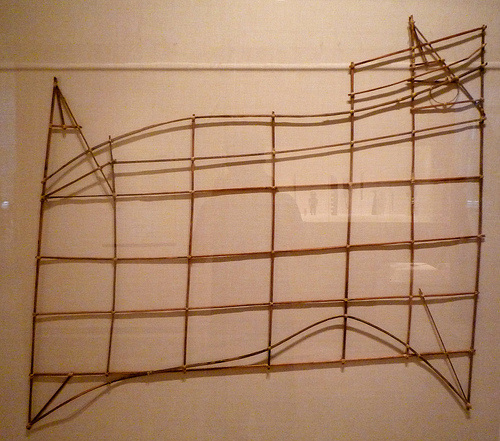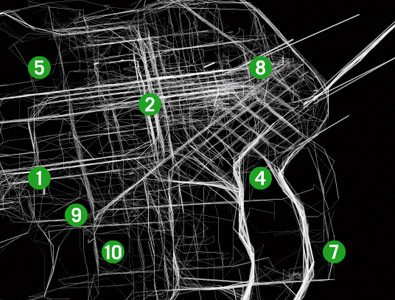Marshall Islands in South Pacific. Strange land that barely rises out of the see. These maps were extremely well mapped before 1900 as navigators made very good stick charts. The best way to move between the islands is to follow the dominating currents (represented on these stick charts).
To navigate them, you can’t think in terms of the infrastructure and you have to think about the way the ocean works.
There are all sorts of dangers if you are excluded from the cloud today. It’s not about the infrastructure but about the flow.
Maps of infrastructure show us what’s possible, but maps of flow show us what actually happens. Example of #flowmapping is Cab Spotting project.
We don’t map flow very often, because mapping flow is an act of surveillance. But by not mapping flow we are missing things.
Lets take a look at what we actually do, instead of what we think we do. We’re not at the peak of globalization, but we’re at the local peak. We’ve got a feeling of globalization because of the availability of global products. As we get “atoms” from everywhere, we assume we can also get “bits” from everywhere.
But generally speaking, we don’t get bits from everywhere. It turns out that it’s really easy to get atoms from Fiji, but it’s really hard to get bits from there. This means that infrastructure matters a lot.
Map of media attention – Technorati based map of which countries people are talking about. There are parts of worlds that we put a lot attention to some countries.
Evolutionary speaking – we humans are not used to thinking globally.
The cloud invites the image of border-less world – in reality, we tend to be pretty parochial. We’re probably ignoring some of the most amazing potential, because cloud lures us into imaginary cosmopolitanism.
We now have a set of tools to shrink the world, but we need help in using them and realizing the full potential of the cloud.
Your view of Facebook is based on the Tribes and is really not a global network. It’s our local environment and we have to recognize this.
We have to take this ocean and sea of possiblity and actually get the sense of what flows through it, instead of assuming that we know what’s happening. We have to resist homophily.
The cloud is not a prediction, it’s a prophecy.
A prophecy is a challenge to the reader. We have to accept the challenge and make sure it happens.
Disclaimer: these notes are my interpretation of the talk and I apologize to the author for any mistakes I made in the process.


phrophecy not prediction – good distinction